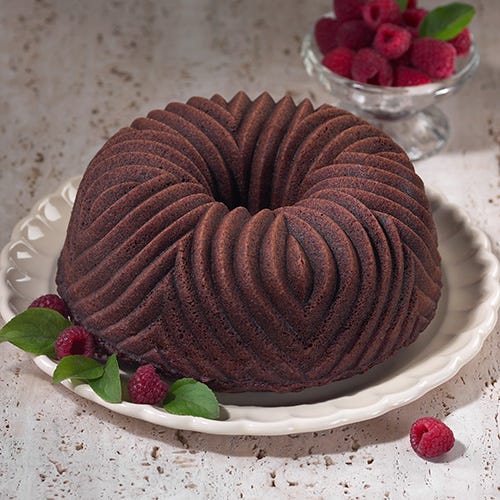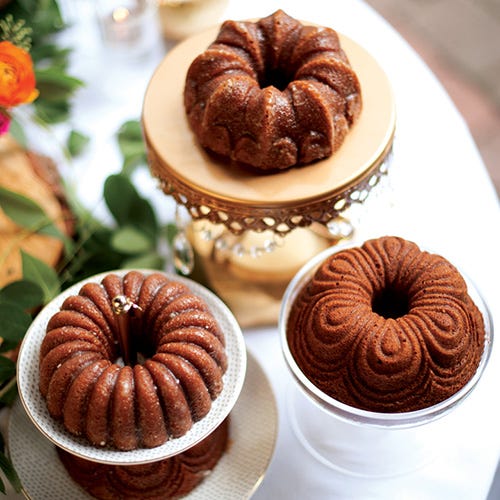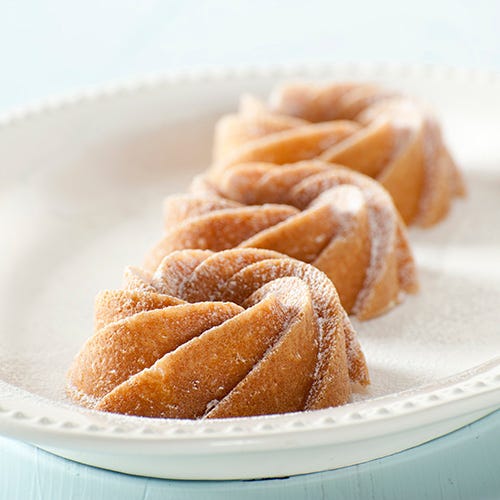A little bit about the Bundt pan
Categories:
Best known for its distinctive ring shape, a Bundt cake is baked in a moulded tin that features flourishes such as swirls and grooves to form intricate designs. There’s no definitive recipe for a Bundt cake. It takes its shape and inspiration from the traditional European Gugelhupf, a brioche-type cake that was popular amongst Jewish communities in Poland, Austria and Germany. The Gugelhupf was traditionally known as ‘Bundkuchen’ in parts of northern Germany. A word formed from two words ‘Bund’ and ‘Kuchen’ meaning cake. Opinion is divided on the true meaning of Bund. One theory is it means ‘bundle’ or ‘bunch’, referring to the way the dough is bundled around the pan. Another theory is the fluted sides resemble the shape of a tied bundle of wheat. There’s also a theory that ‘Bund’ refers to a group or gathering of people. Hence, Bundkuchen is a cake made for gatherings and celebrations. The rise in popularity of the Bundt cake further afield in America is down to husband and wife team Dotty and David Dalquist. With only a few hundred dollars to their name, the couple set up a small kitchenware company in the basement of their home in Minneapolis after the Second World War. Initially Nordic Ware made specialist Scandinavian cookware products like the Krumkake Iron, Ebelskiver Pan and the Rosette Iron. The company was approached to come up with a modern version of the Gugelhupf Pan. This was duly designed from cast aluminium and a small production run made. For trademark purposes Nordic Ware added a ‘t’ to Bund. The initial run was slow to sell and very nearly dropped. Luckily it was used to bake a prize-winning cake in a national baking contest. The resulting popularity eventually led to the Bundt pan outselling America’s most popular pan – the Jell-O mould. From those humble beginnings, Bundt pans can now be found in over 70 million homes around the world and can regularly be seen gracing covers of food magazines and making appearances on countless TV cookery shows. It’s the design of a Bundt cake
cake further afield in America is down to husband and wife team Dotty and David Dalquist. With only a few hundred dollars to their name, the couple set up a small kitchenware company in the basement of their home in Minneapolis after the Second World War. Initially Nordic Ware made specialist Scandinavian cookware products like the Krumkake Iron, Ebelskiver Pan and the Rosette Iron. The company was approached to come up with a modern version of the Gugelhupf Pan. This was duly designed from cast aluminium and a small production run made. For trademark purposes Nordic Ware added a ‘t’ to Bund. The initial run was slow to sell and very nearly dropped. Luckily it was used to bake a prize-winning cake in a national baking contest. The resulting popularity eventually led to the Bundt pan outselling America’s most popular pan – the Jell-O mould. From those humble beginnings, Bundt pans can now be found in over 70 million homes around the world and can regularly be seen gracing covers of food magazines and making appearances on countless TV cookery shows. It’s the design of a Bundt cake that gives it its characteristic feature, not the actual recipe. The hole in the centre of the Bundt tin creates a larger surface area than a traditional-shaped pan, giving better heat distribution throughout the baking process. There are many designs of Bundt pan available. These range from the geometric shapes of the Jubilee Bundt Pan and cascading swirls of the Heritage Bundt Pan to Fleur De Lis and Castle designs that are fit for royalty. CLICK HEREto see the full range of amazing Bundt tins on our website. Decorating the Bundt cake is really down to individual taste. Try drizzling icing across the cake and decorate the top with fruit or chocolate. For a delicious dessert fill the centre of the Bundt with fruits and berries. For a simple Bundt, a dusting of icing sugar delicately dusted across the top gives a beautiful touch. Finished and decorated Bundt cakes can be a real showstopper when entertaining family and friends. This basic Bundt cake recipe can easily be adapted for adding different flavours into the mix, like citrus orange or lemon, chocolate, fruit and nuts.
that gives it its characteristic feature, not the actual recipe. The hole in the centre of the Bundt tin creates a larger surface area than a traditional-shaped pan, giving better heat distribution throughout the baking process. There are many designs of Bundt pan available. These range from the geometric shapes of the Jubilee Bundt Pan and cascading swirls of the Heritage Bundt Pan to Fleur De Lis and Castle designs that are fit for royalty. CLICK HEREto see the full range of amazing Bundt tins on our website. Decorating the Bundt cake is really down to individual taste. Try drizzling icing across the cake and decorate the top with fruit or chocolate. For a delicious dessert fill the centre of the Bundt with fruits and berries. For a simple Bundt, a dusting of icing sugar delicately dusted across the top gives a beautiful touch. Finished and decorated Bundt cakes can be a real showstopper when entertaining family and friends. This basic Bundt cake recipe can easily be adapted for adding different flavours into the mix, like citrus orange or lemon, chocolate, fruit and nuts.
Basic Bundt Recipe
Ingredients
2½ cups plain flour (also known as all-purpose flour) 1½ cups caster sugar 3 medium sized eggs 3½ teaspoons baking powder ¾ cup of butter Pinch of salt Zest and juice of 1 orange or lemon (optional, or add other flavours like coffee or chocolate)
(also known as all-purpose flour) 1½ cups caster sugar 3 medium sized eggs 3½ teaspoons baking powder ¾ cup of butter Pinch of salt Zest and juice of 1 orange or lemon (optional, or add other flavours like coffee or chocolate)
Icing
1 cup icing sugar, sifted 1-2 tablespoons milk (or alternatively same quantities of orange or lemon juice) Place the glaze icing in the fridge for 30mins to thicken Optional – top with chopped nuts or fruit
Method
Heat oven to 350°F / 175°C If you are using a food mixer, simply put everything all in the bowl and start mixing. If you are mixing by hand, begin by mixing the eggs, sugar and butter together to form a smooth mixture. Sift in the flour, baking powder and salt. Mix the ingredients until they are combined. Add in the juice and zest and mix well. Grease and flour your Bundt pan and add the mixture. Don’t fill more than 2/3 of the tin to allow room for the cake to rise. Bake for 35mins or until a knife or cake tester comes out cleanly without mix sticking to the surface. Allow to cool for 10-15 minutes before turning out the cake from the pan. Leave the cake until it is cool to the touch, then drizzle with icing of your choice. For a lighter touch just dust gently with icing sugar.
